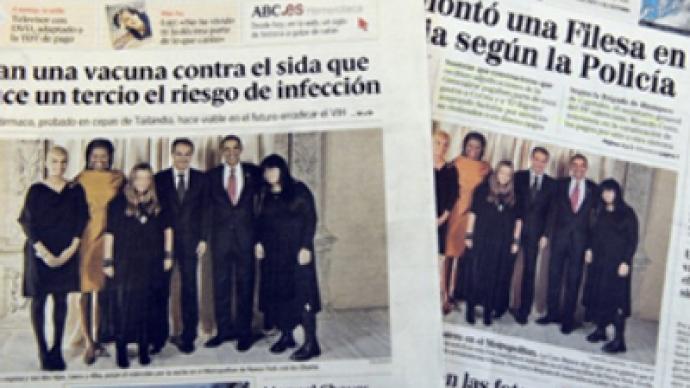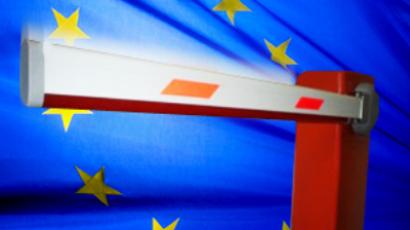Political family snaps – a relative no-no

America wanted to display it proudly. Spain wanted to conceal it ashamedly. The censoring of a photograph of Zapatero's visit to the White House highlights the two countries' different stances on media censorship.
The Spanish Prime Minister's long awaited invitation to the White House has been marred by controversy, with a photograph of the two leaders standing with their wives and Zapatero's formerly “clandestine” teenage daughters. Assuming the US had similar privacy laws protecting the exposure of minors in the media, the Prime Minister was appalled to learn the photograph had been published on the US State Department's website. Co-operating with Zapatero's office, the frantic appeals to have all traces of the photograph removed were honored by the White House, who retracted the picture from the website, although the damage had already been done.
The eagerly-anticipated first glimpses of the Spanish Prime Minister's daughters were predictably plastered around Spain, and appeared in two national newspapers. Much to the delight of both the media and the public, the girls’ gothic attire, which has earned them the nickname the “Addams Family”, are cruelly being said to be the reasons behind Zapatero's continued efforts to censor his daughters’ appearances in the media.
Directly contrasting with the Obama family's calm disposition, natural vivaciousness and ease in front of the cameras, the Spanish prime ministerial family's awkwardness and unease in the public eye could be considered as symbolic of the two countries’ antithetical stances on media censorship.
The forced withdrawal of the photograph from the US website and the accusations made by the Zapatero administration to the Spanish newspapers involved, of breaking the “tactical agreement” on his daughters, is the latest case in an increasing number of incidents involving media censorship or self-censorship in Europe. These episodes have arguably occurred because of restrictive laws or monopolistic patterns in media ownership.
In Europe, special treatment and laws are often granted to the elite and powerful members of society, and anyone found violating these laws can be seriously punished. Perhaps the most famous recent example of this “special attention” being given to prominent figures in Spain was the conviction of an editor and cartoonist, for “damaging the prestige of the Crown” by publishing a cartoon of Prince Felipe and his wife having sex. In Spain, the slandering of a member of the Royal Family can carry a two-year prison sentence. The incident caused a whirlwind of criticism and debate regarding the ethics of “free speech”, with trade unions representing the journalists accusing the Spanish judiciary of obstructing freedom of speech.
However, it is not just the Spanish who are tightening control of media censorship, implementing harsh disciplinary actions for violation cases and ultimately curtailing freedom of expression. The Spanish Royals’ case echoed the more serious incident that took place a year before, when cartoons published of the Prophet Muhammad in European newspapers sparked violent protests which led to a number of deaths and the cartoonists facing death threats. The outcome of the whole affair was seen as a setback for freedom of expression.
Laws similar to those in Spain, which protect the wishes of privileged and powerful individuals, also exist in France. An incident involving a newspaper exposé that showed Nicolas Sarkozy's wife at the time of his presidential election campaign, Cecilia Sarkozy, failing to cast her vote, was “conveniently” removed at the request of the owner of the newspaper, who happened to be a close associate of Sarkozy.
A study titled “Goodbye to Freedom” was published by the Independent Association of European Journalists and revealed that journalists in eighteen of twenty European countries have been prosecuted for violating laws protecting the elite and powerful.
In the US, however, censorship is not at the same level as it is in Europe. America has often been accused of being a “product” manufactured by the government and media to an unsuspecting public who are unable to think “critically”. According to serendipity.com, “Censorship in America works partly on ignoring whatever is inconsistent with the official story.”
The Zapateros and Obamas playing “happy families” at the White House is an image the US Government wants to convey to the world. Although unknowingly to state officials, there was an “inconsistency” with the story. The fact that the Spanish prime minister does not want his daughters exposed to the public would be considered strange in America, and therefore would not be dreamed of leaving out of the media. Because of the “uncritical” nature of the American people, the US has not enforced so many restrictive laws regarding what can and cannot be displayed in the media. The fact that as soon as Zapatero's office pleaded to have the photograph removed, the State Department respected their wishes and cooperated immediately shows that America is unwilling to cause any antipathy between themselves and the so-called most “anti-American leader in Europe today.”
Gabrielle Pickard for RT













